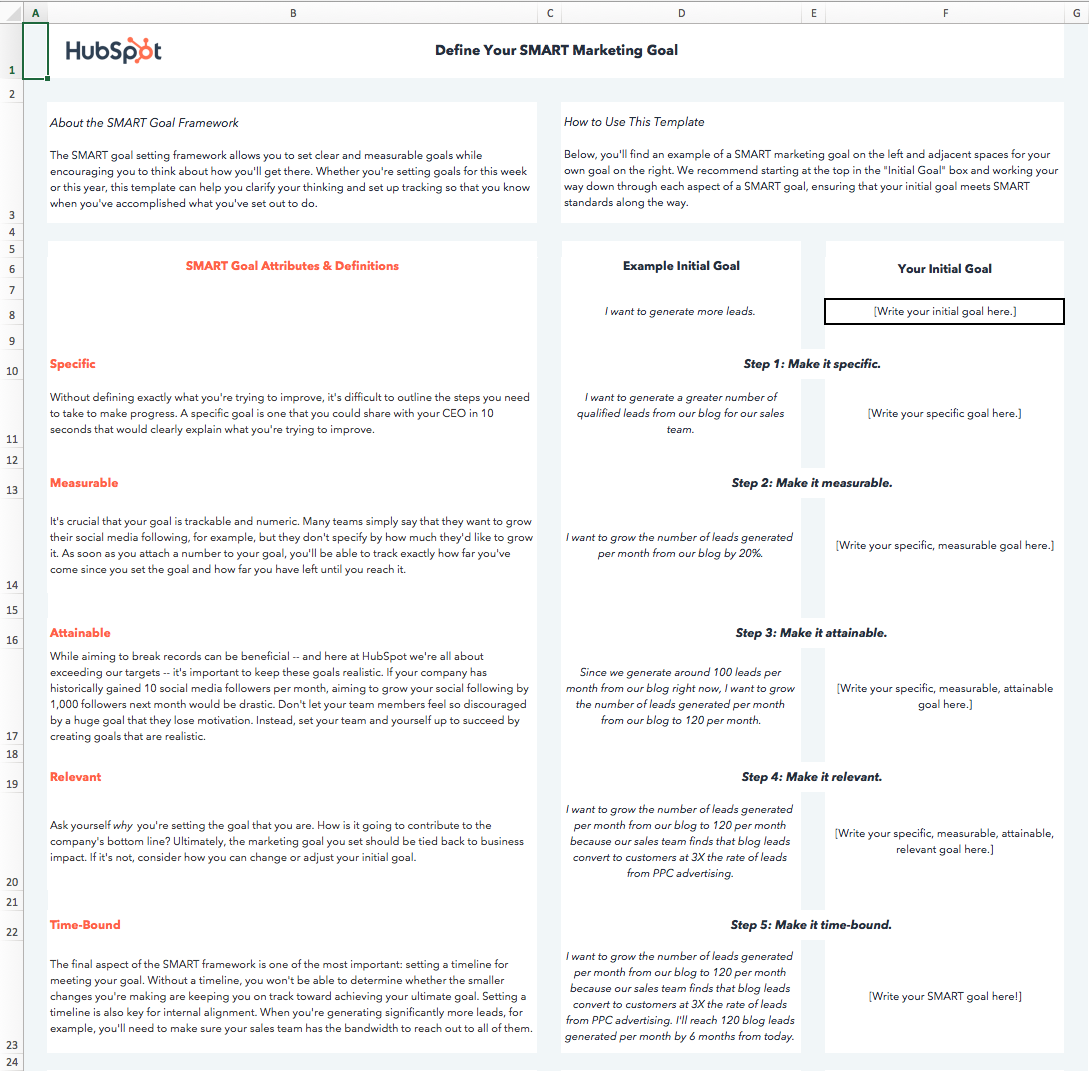How To Set Smart Goals Template
There'southward almost nothing more gratifying than the feeling you get when you achieve a goal. Whether y'all're pressing "Publish" on a blog mail service or collecting initial analytics on a campaign months in the making, information technology's undeniably satisfying to know yous've successfully finished a task. When you lot're non chasing a clear goal, though, work can feel like a never-ending grind. Without goals, you lot're setting yourself up to feel like the piece of work you're doing isn't enough — or, worse, you position yourself to do piece of work that doesn't actually impact your company's bottom line. Making your goals SMART is an effective method for clarifying your motivations, setting a clear direction for yous and your squad members, and ensuring yous're able to celebrate the wins when they come along. To help you lot write SMART goals, we've created a complimentary template with all the tools needed to get you started. Just first — what exactly is a SMART goal, and how does it differ from a regular goal? The letters of SMART stand for: The SMART acronym is a framework that volition enable yous to write goals that drive greater impact. Write goals with each of these aspects in mind, and you'll be able to quantify how far you've come and how far you have left to go against your goal. When y'all achieve the milestone y'all articulated in your SMART goal, you'll be able to celebrate knowing that yous achieved something tangible and impactful. To make the process of setting a SMART goal unproblematic, we've created a free, downloadable SMART goal setting template. I'll walk through the template equally nosotros hash out each aspect of a SMART goal, below. I'd propose downloading the template yourself to follow along throughout the rest of this blog postal service. Next, let's dive into the importance of each aspect of the SMART acronym. While we run through the definition behind each attribute of the SMART framework, we'll use the framework to a real-globe example every bit nosotros become. You can download the template to follow along (input your starting goal in cell F8) or simply write your starting goal on a piece of paper. Let's start with a basic, non-SMART goal as our example — "I desire to go more fit." Goal setting is frequently associated with striving toward our highest aspirations — and actually reaching those aspirations can seem daunting. Specificity helps united states determine the path between where we are, and where we desire to be. "Getting more fit" is ambiguous. There are innumerable ways to become more fit, and everyone has their own definition of fitness — for instance, are you looking to lose weight? Perform more push-ups? Cutting a minute off your mile time? When a goal isn't specific, in that location is no style to tell whether the actions y'all're taking are going to help you lot accomplish that goal. If your specific fitness goal is actually to increase the number of button-ups yous can do at one time, following a running plan isn't going to be very helpful in getting you to your true goal. A specific goal is one that makes your adjacent steps clear — or, at the very to the lowest degree, narrows downwardly the potential side by side steps you lot might take. To specify what we hateful by "I want to get more fit,'' I'll change our example goal to read, "I want to be able to do more button-ups." If yous're following forth in the template, make your goal more than specific and blazon it into the prison cell under Step 1. When a goal is measurable, you can easily track your progress. Typically, this means that a number volition exist attached to your goal. A numerical goal is valuable for many reasons. In improver to giving you something to strive toward, you'll be able to celebrate a victory when you lot reach the concluding benchmark. If you say that you merely want to do more push-ups", for example, does that mean that you desire to be able to complete just one more push button-up per session, or that you desire to double the number of push-ups y'all tin can do overall? I goal volition take a lot more time and dedication to achieve than the other. Let's say I tin practice ten push-ups in a row right at present. To allow us to measure our progress against our final goal and know when we've reached a milestone, we'll edit our push-ups goal to read, "I desire to be able to do 25 button-ups in a row." I've set some pretty lofty goals earlier — and if you're reading this, you're probably a self-motivated person, too. Large aspirations are admirable, simply it's important to residue long-term goals with more than achievable, short-term goals. Setting attainable goals is all about looking at what you've done so far and adjusting your goals to be realistic relative to those benchmarks. To consider the point in more concrete terms, recollect about business organisation growth rates — if your visitor has been selling 2% more than product each calendar month for the by 12 months, aiming to sell 15% more product next month would be an unrealistic goal. Keep in mind that ii% growth is the status quo — and so a skillful stretch goal might be selling 3 or four% more product next calendar month. Selling 4% more product would even so exist doubling your calendar month-over-month growth. Each month, you lot'll be aiming for the familiar satisfaction of striking your target rather than dreading another seemingly major miss. For example, to make our case goal a chip more accessible, I'll move the target from 25 push-ups to 20 push-ups. In that location's still a significant amount of work required to become to where I want to exist, merely I'll be able to celebrate a huge achievement — doubling the amount of push-ups I can do — and use that momentum and celebration to bulldoze me to fix a goal of doing 25 button-ups shortly afterwards I accomplish my goal of 20. Consider what y'all've done in the past in relation to the goal you're in the procedure of setting, and conform it accordingly. Relevant goals are ones that will help you move in the direction y'all truly want. You can allocate your time to an infinite amount of activities, just which activities volition actually push y'all closest to your ultimate goals? It's a common trap to feel like nosotros're being productive when nosotros're busy, fifty-fifty if our activeness isn't creating a meaningful affect. In the beginning, our example goal was to "get more than fit." To brand sure our goal is relevant, nosotros demand to ask ourselves whether following through on this goal will really help us get to where we want to be. In the case of our push-upwardly goal, the reply is yep. Push-ups engage several muscle groups, including your back, arms, shoulders, and cadre, and doing a pregnant number consecutively can definitely drag your centre rate. Therefore, executing on this goal will better my muscular strength and perchance even my cardiovascular forcefulness, both of which are key elements to overall fitness. Inquire yourself whether the goal you lot've set is going to create real affect on your overarching targets, and adjust it or place a way to track touch if the answer is currently no. I'll adjust our example goal to include its overarching purpose: "I want to exist able to do 20 push-ups in a row to amend my overall muscular fitness." The final letter of the SMART acronym stands for time-bound. You should always aim to accomplish your goal within a specific time period. Adding in a fourth dimension frame will not only motivate you to take steps every day toward your goal, but also permit you to rail how much progress you've fabricated confronting your goal versus the fourth dimension that'due south passed. If I'm aiming to increase the number of push-ups I tin can do past ten in two months, I'yard able to prepare a midpoint milestone of adding five push-ups in the commencement month. If a month passes and I've simply increased the number past three, I'll know I need to ramp upwards my efforts, re-evaluate my strategy for increasing my push-up strength, or adjust the time frame I initially chose. Additionally, a time frame tin can help yous chart your progress. I'll make our example goal time-bound by proverb, "I want to exist able to exercise 20 consecutive push button-ups 2 months from today to ameliorate my overall muscular fitness." Now, I have a goal that clarifies the path to where I desire to exist. In the terminal tab of the SMART goals template, y'all'll be able to document the roadblocks to achieving your goal that you conceptualize, and make an action programme for overcoming those roadblocks to set you off on the right foot. Download the Template Before I fabricated my goal SMART, it would've been easy for me to make excuses. It wasn't articulate how I'd measure whether I'd gotten fitter, or when I was going to check-in with myself to come across whether I had. When writing SMART goals, keep in mind that they are "specific" in that there's a difficult and fast destination the employee is trying to attain. "Go better at my job," isn't a SMART goal considering it isn't specific. Instead, inquire yourself: What are you getting better at? How much better practise you want to go? If you're a marketing professional, your job probably revolves effectually key operation indicators or KPIs. Therefore, you might choose a item KPI or metric that you want to improve on — like visitors, leads, or customers. You lot should too identify the squad members working toward this goal, the resources they take, and their plan of activeness. In practice, a specific SMART goal might say, "Clifford and Braden will increase the blog's traffic from email ..." You know exactly who's involved and what you're trying to improve on. While you may need to keep some goals more open-ended, yous should avoid vagueness that could confuse your team subsequently on. For case, instead of saying, "Clifford will boost email marketing experiences," say "Clifford will boost e-mail marketing click rates past 10%." SMART goals should exist "measurable" in that you lot can track and quantify the goal'south progress. "Increment the blog's traffic from email," by itself, isn't a SMART goal because you can't mensurate the increase. Instead, ask yourself: How much e-mail marketing traffic should y'all strive for? If yous want to judge your team's progress, yous need to quantify your goals, like achieving an X-percentage increase in visitors, leads, or customers. Let's build on the SMART goal we started three paragraphs in a higher place. Now, our measurable SMART goal might say, "Clifford and Braden will increment the blog's traffic from email by 25% more sessions per month ... " You know what you're increasing, and by how much. This is in the aforementioned light of avoiding vagueness. While you might need qualitative or open-ended show to testify your success, you should yet come up upwardly with a quantifiable KPI. For example, instead of saying, "Customer service will ameliorate customer happiness," say, "We want the boilerplate call satisfaction score from customers to be a 7 out of ten or college." An "attainable" SMART goal considers the employee's power to achieve it. Brand sure that 10-percentage increment is rooted in reality. If your blog traffic increased by five% last month, try to increase it by 8-10% this calendar month, rather than a lofty 25%. It's crucial to base of operations your goals on your own analytics, non industry benchmarks, or else you might bite off more than than you can chew. So, let'southward add some "attainability" to the SMART goal nosotros created earlier in this blog post: "Clifford and Braden will increase the blog's traffic from email by viii-10% more sessions per month ... " This mode, yous're not setting yourself up to fail. Yes. You lot should ever aim to amend. But reaching for completely unattainable goals may knock you off grade and make it harder to track progress. Rather than maxim, "We desire to make 10,000% of what we made in 2022," consider something more attainable, like, "We want to increase sales by 150% this twelvemonth," or "We have a quarterly goal to reach a xx% year-over-twelvemonth sales increase." SMART goals that are "relevant" chronicle to your company's overall business goals and account for current trends in your industry. For instance, volition growing your traffic from e-mail lead to more revenue? And, is it actually possible for you to significantly heave your web log's email traffic given your electric current email marketing campaigns? If you're aware of these factors, you're more than likely to set up goals that benefit your company — not just y'all or your section. So, what does that exercise to our SMART goal? It might encourage you to adjust the metric yous're using to rail the goal's progress. For example, possibly your business has historically relied on organic traffic for generating leads and revenue, and research suggests you lot can generate more qualified leads this way. Our SMART goal might instead say, "Clifford and Braden volition increment the web log'due south organic traffic by 8-x% more sessions per month." This way, your traffic increment is aligned with the business's revenue stream. When your company is doing well, it can be easy to say y'all want to pin or grow in another management. While companies tin can successfully practice this, you lot don't desire your squad to lose sight of how the core of your business organization works. Rather than saying, "Nosotros desire to kickoff a new B2B business on height of our B2C business," say something like, "Nosotros want to keep increasing B2C sales while researching the bear on our products could have on the B2B space in the next year." A "time-leap" SMART goal keeps yous on schedule. Improving on a goal is great, simply not if it takes too long. Attaching deadlines to your goals puts a healthy dose of pressure level on your squad to accomplish them. This helps yous make consistent and significant progress in the long term. For example, which would you prefer: increasing organic traffic by 5% every calendar month, leading to a thirty-35% increment in one-half a year? Or trying to increase traffic by fifteen% with no deadline and achieving that goal in the aforementioned timeframe? If yous picked the former, y'all're right. So, what does our SMART goal look like once nosotros jump it to a timeframe? "Over the next three months, Clifford and Braden volition work to increase the weblog's organic traffic by 8-10%, reaching a total of 50,000 organic sessions by the end of Baronial." Having no timeframe or a really broad span of time noted in your goal volition cause the effort to become reprioritized or brand it difficult for you to see if your team is on rails. Rather than proverb. "This twelvemonth, we want to launch a major entrada," say, "In quarter one, we will focus on campaign production in order to launch the campaign in quarter two." With my new SMART goal, I have a clear target to aim for and a metric for success. I can quickly evaluate whether I'm on pace with achieving my goal or behind, and I tin gloat the accomplishment when it does come because it's a realistic metric that's relevant to my ultimate goal. Editor's notation: This post was originally published in September 2022 and has been updated for comprehension. 
What is a SMART goal?

What does each attribute of the SMART acronym actually mean?
1. Specific

ii. Measurable
3. Accessible
Accessible goals are useful because they assist yous maintain momentum. It tin can be hugely discouraging to miss huge targets, whereas consistently making small gains will encourage you to continue delivering wins.
4. Relevant
five. Time-bound

How To Brand a SMART Goal
1. Use specific wording.
Mutual SMART Goal Mistake: Vagueness
2. Include measurable goals.
Common SMART Goal Mistake: No KPIs
3. Aim for realistically attainable goals.
Common SMART Goal Mistake: Unattainable Goals
four. Pick relevant goals that relate to your concern.
Common SMART Goal Error: Losing Sight of the Visitor
five. Make goals time-leap by including a timeframe and deadline information.
Common SMART Goal Mistake: No Fourth dimension Frame


Originally published Sep 11, 2022 seven:00:00 AM, updated January 25 2022
How To Set Smart Goals Template,
Source: https://blog.hubspot.com/marketing/how-to-write-a-smart-goal-template
Posted by: martinezswee1991.blogspot.com


0 Response to "How To Set Smart Goals Template"
Post a Comment